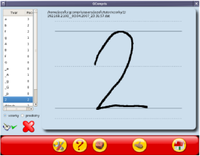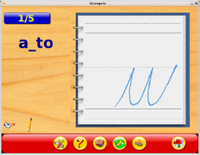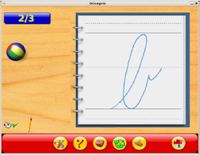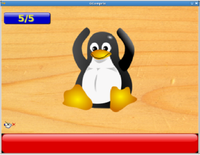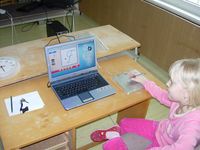Difference between revisions of "Writing tutor"
(Reverted edit of OrsitLatro, changed back to last version by Bruno) |
(→References) |
||
| (3 intermediate revisions by 2 users not shown) | |||
| Line 1: | Line 1: | ||
| − | = Writing Tutor | + | = Writing Tutor — Computer helps children learn to write = |
== WARNING: This activity has never reached a usable level and was in experimental. As I move towards the goocanvas, I did not port it and it's no more shipped. == | == WARNING: This activity has never reached a usable level and was in experimental. As I move towards the goocanvas, I did not port it and it's no more shipped. == | ||
== Abstract == | == Abstract == | ||
| − | Using the graphic tablet as a writing tool together with specially designed software brings a new dimension to the process of teaching children to write. It can make the education process easier for teachers and more interesting for pupils. This paper deals with the education game | + | Using the graphic tablet as a writing tool together with specially designed software brings a new dimension to the process of teaching children to write. It can make the education process easier for teachers and more interesting for pupils. This paper deals with the education game ‘Writing Tutor’, which allows children to learn and improve their writing of letters, words and symbols in various activities. During particular activities of the game, data written on the tablet have been processed, using the special algorithms for pattern recognition. The tablet data have been evaluated and finally the result of a success is announced. It is possible to exercise a shape of a letter according to a pattern, guessing a missing letter, practising of minims, etc. The environment of the game is designed for children who are starting to learn writing. |
'''Keywords: handwriting recognition, tablet, education of writing for children.''' | '''Keywords: handwriting recognition, tablet, education of writing for children.''' | ||
| Line 10: | Line 10: | ||
== Introduction == | == Introduction == | ||
| − | Children education process on elementary schools can be enriched variously. The application Penguin Quart [5] has shown that a microphone connected to a computer can bring mathematics closer to an entertainment level. It teaches children to read numbers by playful form. Another project | + | Children education process on elementary schools can be enriched variously. The application Penguin Quart [5] has shown that a microphone connected to a computer can bring mathematics closer to an entertainment level. It teaches children to read numbers by playful form. Another project — Multimedia Reading Book [6] — helps teachers to teach K-4 children to read. |
| − | This paper concentrates on the development of writing skills of young children at the first grade. At first, they usually use pencils and write various shapes on paper according to patterns. Later, after a longer exercising, they try to write letters. Teachers check and assess | + | This paper concentrates on the development of writing skills of young children at the first grade. At first, they usually use pencils and write various shapes on paper according to patterns. Later, after a longer exercising, they try to write letters. Teachers check and assess pupils’ work, correcting as appropriate. |
| − | Nowadays, it is common for children at the age of | + | Nowadays, it is common for children at the age of 6–7 years to have used a computer and to be able to use it for simple operations. Using a graphic tablet as a writing tool together with a special software brings a new dimension in this sphere, not just for pupils, but also for teachers; it can make the work for teachers easier and make the education process for children more interesting. A graphic pen can be used as an equivalent of a pencil and writing on a tablet imitates writing on paper. Taking this idea as a base, a wide spectrum of possibilities of a concrete utilization can be offered. Pupils can be inspired positively to writing letters by designing and creating suitable exercises. A computer will check and correct written shapes automatically (though not in quite the same way as a human would). |
Using the graphic tablet in an education process brings a relatively new form of the interaction between a pupil and a computer. | Using the graphic tablet in an education process brings a relatively new form of the interaction between a pupil and a computer. | ||
| − | The application | + | The application “Writing Tutor” enables children to learn and improve their writing of letters, words, symbols. Written data from the tablet using special algorithms for identification of shapes have been executed during particular activities of the game. Finally, a result has been announced. It is possible to exercise a shape of a letter according to a pattern, guessing a missing letter, practicing of minims, etc. |
The environment of the game is designed for children, that are starting to learn writing. The game can be widened easily. Teachers can fill up his own shapes, patterns, activities, etc. | The environment of the game is designed for children, that are starting to learn writing. The game can be widened easily. Teachers can fill up his own shapes, patterns, activities, etc. | ||
| Line 41: | Line 41: | ||
The suitable algorithm is DTW (Dynamic Time Warping) which works on the principle of dynamic programming. Its idea consists of finding of the smallest distance of two sequences considering all acceptable transformation paths. The distance (Euclidean, Manhattan,...), that considers ''i''-th point of the first sequence with ''i''-th point of the second sequence produces a weak rate of similarity. | The suitable algorithm is DTW (Dynamic Time Warping) which works on the principle of dynamic programming. Its idea consists of finding of the smallest distance of two sequences considering all acceptable transformation paths. The distance (Euclidean, Manhattan,...), that considers ''i''-th point of the first sequence with ''i''-th point of the second sequence produces a weak rate of similarity. | ||
| − | Non-linear (elastic) consideration creates a more intuitive rate of similarity. It enables to consider shapes, that are in sequence, eventually moved in a time (it considers ''i''-th point with ''i''-th + ''j''-th point). | + | Non-linear (elastic) consideration creates a more intuitive rate of similarity. It enables to consider shapes, that are in sequence, eventually moved in a time (it considers ''i''-th point with ''i''-th + ''j''-th point). “Elastic” consideration is the basis of the algorithm DTW. The time and pressure component of coordinates is not considered in my suggested algorithm but if Hidden Markov Models (HMM) are used they will be necessary [8]. |
== Writing Tutor == | == Writing Tutor == | ||
| Line 47: | Line 47: | ||
This game enables kids to exercise writing of various shapes and checks its correctness in the interactive and entertaining way. It consists of a package of game activities. Their principles are common. At first model of a letter is showed, not at once but progressively. | This game enables kids to exercise writing of various shapes and checks its correctness in the interactive and entertaining way. It consists of a package of game activities. Their principles are common. At first model of a letter is showed, not at once but progressively. | ||
| − | Children can watch how to write the letter. After the demonstration, children try to write the same shape as the model. They are using the graphic tablet of course. The writing model is shown all the time and is colored by a different, dim, color. Children can consider their written shape and click on the button | + | Children can watch how to write the letter. After the demonstration, children try to write the same shape as the model. They are using the graphic tablet of course. The writing model is shown all the time and is colored by a different, dim, color. Children can consider their written shape and click on the button “Check answer” which is illustrated by a hand with standing thumb. Pupils are informed about the success of writing by animation or sound. It the case of the good result, they are moved forward to next level. |
Guiding lines are shown dynamically according to shape of the letter to be written [9]. | Guiding lines are shown dynamically according to shape of the letter to be written [9]. | ||
| Line 53: | Line 53: | ||
=== The Activities === | === The Activities === | ||
[[Image:writing_tutor1.png|thumb|200 px]] | [[Image:writing_tutor1.png|thumb|200 px]] | ||
| − | * Drawing/copying a pattern | + | * Drawing/copying a pattern – a specific pattern of a letter, a number or a symbol is displayed to a pupil. His task is to draw the most similar shape. After successful drawing, a next shape can be exercised. A sequence of exercised shapes is determined by a teacher. |
| − | * Completing a missing letter | + | * Completing a missing letter – a word with a missing letter is displayed on a display. The task of a pupil is to complete a missing letter. |
| − | * Guessing the first letter of a picture | + | * Guessing the first letter of a picture – a pupil has to guess the first letter of the name of the picture and then write it correctly. |
[[Image:writing_tutor2.png|thumb|200 px]] | [[Image:writing_tutor2.png|thumb|200 px]] | ||
| − | * Drawing of geometrical figures | + | * Drawing of geometrical figures – pupils draw geometrical figures according to a picture. |
[[Image:writing_tutor3.png|thumb|200 px]] | [[Image:writing_tutor3.png|thumb|200 px]] | ||
| Line 68: | Line 68: | ||
Operating system Gnu/Linux with graphical extension (X-server) and open-source educational software GCompris [7] have been chosen as a platform for a realization. The software GCompris has already prepared a customer environment for children from 3 to 10 years old. This game provides easy and entertaining use [3]. The game is easy to extend in the form of plug-ins. | Operating system Gnu/Linux with graphical extension (X-server) and open-source educational software GCompris [7] have been chosen as a platform for a realization. The software GCompris has already prepared a customer environment for children from 3 to 10 years old. This game provides easy and entertaining use [3]. The game is easy to extend in the form of plug-ins. | ||
| − | Writing Tutor uses the standard graphic tablet which is configured at the operating system level. An appropriate driver provide same functionality like mouse with earlier mentioned improvements. (If a tablet is not present then a mouse can be used instead; though see section | + | Writing Tutor uses the standard graphic tablet which is configured at the operating system level. An appropriate driver provide same functionality like mouse with earlier mentioned improvements. (If a tablet is not present then a mouse can be used instead; though see section ‘Advantages of Graphic Tablet’ above.) |
The comparative algorithm is based on DTW with acceptable results. Because children must follow writing model, which is permanently shown, the DTW comparison is good. Problems would be with randomly or not proportionally written shapes. It can be solved by HMM approach to written shapes recognition. | The comparative algorithm is based on DTW with acceptable results. Because children must follow writing model, which is permanently shown, the DTW comparison is good. Problems would be with randomly or not proportionally written shapes. It can be solved by HMM approach to written shapes recognition. | ||
| Line 75: | Line 75: | ||
=== The Experiment === | === The Experiment === | ||
[[Image:writing_tutor4.jpg|thumb|200 px]] | [[Image:writing_tutor4.jpg|thumb|200 px]] | ||
| − | The set of experiments was realized on the Elementary school in | + | The set of experiments was realized on the Elementary school in Černysevsky street, Bratislava. Their objectives were: the improvement of the application by finding objectionable parts, a collection of patterns and finally finding out effects and the asset of using the writing tutor in a practice. |
{| | {| | ||
| Line 84: | Line 84: | ||
|b || 63 || 37 || 22 || 8,12 | |b || 63 || 37 || 22 || 8,12 | ||
|- | |- | ||
| − | | | + | |č || 43 || 57 || 16 || 12,3 |
|- | |- | ||
|i || 37 || 63 || 8 || 12,99 | |i || 37 || 63 || 8 || 12,99 | ||
| Line 117: | Line 117: | ||
== References == | == References == | ||
| − | * [1] Read, J. C., MacFarlane, S. J., and Horton, M., | + | * [1] Read, J. C., MacFarlane, S. J., and Horton, M., “The Usability of Handwriting Recognition for Writing in the Primary Classroom,” HCI2004, Leeds, UK, 2004. |
| − | * [2] Read, J., MacFarlane, S. and Casey, C., | + | * [2] Read, J., MacFarlane, S. and Casey, C., “Oops! Silly me! Errors in a Handwriting Recognition-based Text entry Interface for Children,” NordiCHI2002, Aarhus, Denmark, ACM, 2002. |
| − | * [3] Nagy, M., | + | * [3] Nagy, M., „Využitie OS Linux v školských počítačových učebniach,“ (2005), Príspevok z konferencie INFOVEK 2003, Spišská nová Ves, Slovakia |
| − | * [4] Myers, C. S., Rabiner, L. R., | + | * [4] Myers, C. S., Rabiner, L. R., “A comparative study of several dynamic time-warping algorithms for connected word recognition,” The Bell System Technical Journal, 60(7):1389-1409, September 1981. |
| − | * [5] Nagy, M., | + | * [5] Nagy, M., “Utilizing an Education Game PenguinQuart to Develop a Speech Recognition of Slovak Digits,” In Proceedings of the 8th international conference, Informatics 2005, Technopol, Bratislava, pp. 119 – 124 |
| − | * [6] Nagy, M., | + | * [6] Nagy, M., “Multimedia Reading Book - Utilization an XML Document Format and an Audio Signal Processing,” In Proceedings of the 3rd international conference, Slovko 2005, Bratislava, pp. 141 – 146 |
* [7] Free Education Software GCompris, http://gcompris.net | * [7] Free Education Software GCompris, http://gcompris.net | ||
| − | * [8] Young, S., Evermann, G., Kershaw, D., Moore, G., Odell, J., Ollason, D., Povey, D., Valtchev, V., Woodland, P., | + | * [8] Young, S., Evermann, G., Kershaw, D., Moore, G., Odell, J., Ollason, D., Povey, D., Valtchev, V., Woodland, P., “The HTK Book Version 3.2,” Cambridge, England, Cambridge University, 2002 |
| − | * [9] | + | * [9] Dienerová E., “Píšem prvé písmenká...”, SPN – Mladé Letá, s.r.o., Bratislava, 2006 |
| − | * [10] | + | * [10] Červeň J., “Počítač učiteľ písania”, Diploma thesis, FMPH UK, Bratislava, 2007 |
| + | |||
| + | [[Category:English]] | ||
Latest revision as of 12:21, 27 January 2015
Contents
- 1 Writing Tutor — Computer helps children learn to write
Writing Tutor — Computer helps children learn to write
WARNING: This activity has never reached a usable level and was in experimental. As I move towards the goocanvas, I did not port it and it's no more shipped.
Abstract
Using the graphic tablet as a writing tool together with specially designed software brings a new dimension to the process of teaching children to write. It can make the education process easier for teachers and more interesting for pupils. This paper deals with the education game ‘Writing Tutor’, which allows children to learn and improve their writing of letters, words and symbols in various activities. During particular activities of the game, data written on the tablet have been processed, using the special algorithms for pattern recognition. The tablet data have been evaluated and finally the result of a success is announced. It is possible to exercise a shape of a letter according to a pattern, guessing a missing letter, practising of minims, etc. The environment of the game is designed for children who are starting to learn writing.
Keywords: handwriting recognition, tablet, education of writing for children.
Introduction
Children education process on elementary schools can be enriched variously. The application Penguin Quart [5] has shown that a microphone connected to a computer can bring mathematics closer to an entertainment level. It teaches children to read numbers by playful form. Another project — Multimedia Reading Book [6] — helps teachers to teach K-4 children to read.
This paper concentrates on the development of writing skills of young children at the first grade. At first, they usually use pencils and write various shapes on paper according to patterns. Later, after a longer exercising, they try to write letters. Teachers check and assess pupils’ work, correcting as appropriate.
Nowadays, it is common for children at the age of 6–7 years to have used a computer and to be able to use it for simple operations. Using a graphic tablet as a writing tool together with a special software brings a new dimension in this sphere, not just for pupils, but also for teachers; it can make the work for teachers easier and make the education process for children more interesting. A graphic pen can be used as an equivalent of a pencil and writing on a tablet imitates writing on paper. Taking this idea as a base, a wide spectrum of possibilities of a concrete utilization can be offered. Pupils can be inspired positively to writing letters by designing and creating suitable exercises. A computer will check and correct written shapes automatically (though not in quite the same way as a human would).
Using the graphic tablet in an education process brings a relatively new form of the interaction between a pupil and a computer.
The application “Writing Tutor” enables children to learn and improve their writing of letters, words, symbols. Written data from the tablet using special algorithms for identification of shapes have been executed during particular activities of the game. Finally, a result has been announced. It is possible to exercise a shape of a letter according to a pattern, guessing a missing letter, practicing of minims, etc. The environment of the game is designed for children, that are starting to learn writing. The game can be widened easily. Teachers can fill up his own shapes, patterns, activities, etc.
Graphic Tablet as the Education Tool for Writing
The tablet is an alternative to common computer facilities, like a mouse, a touchpad, a trackball, etc. It is used as a computer cursor positioning device. It means, that it has similar characteristics like the mouse, but with some advantages.
Advantages of Graphic Tablet
- measurement of pressure and tilt: higher pressure of the pen on the tablet makes a thicker line. It is a same principle like writing with a pencil on the paper. It cannot be done by using a mouse.
- natural tool: children start to draw with color pencils in a kindergarten. At schools they start to write with a pen. The pen is more natural tool for writing than a mouse. Signing with the mouse and then with the pen by using the graphic tablet is of the great difference.
- absolute location of a cursor: when we want to move the cursor using a mouse from the right top corner of a display down to the left corner we are restricted by a size of a mouse pad, eventually by a free space on a table. The active field of the tablet (a part, where the tablet scans a position of the pen) is equal to the field of the display. All points of the display are then easier to access.
The Recognition of the Correctness of Written Shapes
It is important to use an appropriate algorithm to check the correctness of written shapes by the tablet. The chosen algorithm has to compare a written shape with a pattern saved in the computer. It evaluates the rate of success according to a similarity of these two shapes. According to the final rate of success, it is determined whether the written shape fits to the correct pattern.
Data written by the tablet are represented as a sequence of coordinates. Coordinates (x, y) show a position of the pen in the specific point and coordinate (z) characterizes a pressure that has been made during writing the point. It means that the written pattern is determined by specific sequence of coordinates of mentioned meaning.
Intervals between two coordinates in sequence are not equidistant because an operating system reduces potentially too many events which would overload a computer. Therefore fourth coordinate is time when (x,y,z) was taken from the tablet device. The task of our algorithm is to find the rate of similarity of these two sequences.
The suitable algorithm is DTW (Dynamic Time Warping) which works on the principle of dynamic programming. Its idea consists of finding of the smallest distance of two sequences considering all acceptable transformation paths. The distance (Euclidean, Manhattan,...), that considers i-th point of the first sequence with i-th point of the second sequence produces a weak rate of similarity.
Non-linear (elastic) consideration creates a more intuitive rate of similarity. It enables to consider shapes, that are in sequence, eventually moved in a time (it considers i-th point with i-th + j-th point). “Elastic” consideration is the basis of the algorithm DTW. The time and pressure component of coordinates is not considered in my suggested algorithm but if Hidden Markov Models (HMM) are used they will be necessary [8].
Writing Tutor
This game enables kids to exercise writing of various shapes and checks its correctness in the interactive and entertaining way. It consists of a package of game activities. Their principles are common. At first model of a letter is showed, not at once but progressively.
Children can watch how to write the letter. After the demonstration, children try to write the same shape as the model. They are using the graphic tablet of course. The writing model is shown all the time and is colored by a different, dim, color. Children can consider their written shape and click on the button “Check answer” which is illustrated by a hand with standing thumb. Pupils are informed about the success of writing by animation or sound. It the case of the good result, they are moved forward to next level.
Guiding lines are shown dynamically according to shape of the letter to be written [9].
The Activities
- Drawing/copying a pattern – a specific pattern of a letter, a number or a symbol is displayed to a pupil. His task is to draw the most similar shape. After successful drawing, a next shape can be exercised. A sequence of exercised shapes is determined by a teacher.
- Completing a missing letter – a word with a missing letter is displayed on a display. The task of a pupil is to complete a missing letter.
- Guessing the first letter of a picture – a pupil has to guess the first letter of the name of the picture and then write it correctly.
- Drawing of geometrical figures – pupils draw geometrical figures according to a picture.
Special teacher module
A teacher has a special module, where it is possible to create new shapes/letters and fill in their writing models. This module also makes collecting of patterns possible. The patterns are used in classification algorithms. The DTW algorithm compares correctness of children writing shapes according to saved shape models and patterns. It is able to configure specific activities in the mentioned module.
The Realization
Operating system Gnu/Linux with graphical extension (X-server) and open-source educational software GCompris [7] have been chosen as a platform for a realization. The software GCompris has already prepared a customer environment for children from 3 to 10 years old. This game provides easy and entertaining use [3]. The game is easy to extend in the form of plug-ins.
Writing Tutor uses the standard graphic tablet which is configured at the operating system level. An appropriate driver provide same functionality like mouse with earlier mentioned improvements. (If a tablet is not present then a mouse can be used instead; though see section ‘Advantages of Graphic Tablet’ above.)
The comparative algorithm is based on DTW with acceptable results. Because children must follow writing model, which is permanently shown, the DTW comparison is good. Problems would be with randomly or not proportionally written shapes. It can be solved by HMM approach to written shapes recognition. Collected patterns and results of specific activities are saved and can be sent via net to a teacher for a checking.
The Experiment
The set of experiments was realized on the Elementary school in Černysevsky street, Bratislava. Their objectives were: the improvement of the application by finding objectionable parts, a collection of patterns and finally finding out effects and the asset of using the writing tutor in a practice.
| model | %passed | %failed | occurence | avg writing time [s] |
|---|---|---|---|---|
| a | 63 | 37 | 30 | 10,16 |
| b | 63 | 37 | 22 | 8,12 |
| č | 43 | 57 | 16 | 12,3 |
| i | 37 | 63 | 8 | 12,99 |
| g | 66 | 34 | 6 | 10,75 |
| B | 58 | 42 | 12 | 12,13 |
| F | 55 | 45 | 9 | 17,28 |
| K | 57 | 43 | 7 | 13,63 |
| N | 100 | 0 | 5 | 10,56 |
| V | 100 | 0 | 4 | 8,19 |
| 1 | 100 | 0 | 5 | 5,94 |
| 2 | 100 | 0 | 3 | 5,12 |
| 3 | 66 | 34 | 3 | 10,77 |
Table shows some statistics data, average writing time of the one model using tablet was 10 seconds, the success of the correct writing was 70% (using DTW algorithm for pattern matching).
Conclusion
For a consideration of experiments performed, it can be stated that the game represents a new interactive tool for pupils and teachers. It enables pupils to improve their skills in the writing of various shapes in the interesting way. It makes the education process for teachers easier because of automatic control and checking of pupils.
The plan for the next development is to improve a determination of shapes by using the mechanism HMM (Hidden Markov Model).
The topic mentioned in this paper is elaborated in detail in the diploma thesis of the author [10].
References
- [1] Read, J. C., MacFarlane, S. J., and Horton, M., “The Usability of Handwriting Recognition for Writing in the Primary Classroom,” HCI2004, Leeds, UK, 2004.
- [2] Read, J., MacFarlane, S. and Casey, C., “Oops! Silly me! Errors in a Handwriting Recognition-based Text entry Interface for Children,” NordiCHI2002, Aarhus, Denmark, ACM, 2002.
- [3] Nagy, M., „Využitie OS Linux v školských počítačových učebniach,“ (2005), Príspevok z konferencie INFOVEK 2003, Spišská nová Ves, Slovakia
- [4] Myers, C. S., Rabiner, L. R., “A comparative study of several dynamic time-warping algorithms for connected word recognition,” The Bell System Technical Journal, 60(7):1389-1409, September 1981.
- [5] Nagy, M., “Utilizing an Education Game PenguinQuart to Develop a Speech Recognition of Slovak Digits,” In Proceedings of the 8th international conference, Informatics 2005, Technopol, Bratislava, pp. 119 – 124
- [6] Nagy, M., “Multimedia Reading Book - Utilization an XML Document Format and an Audio Signal Processing,” In Proceedings of the 3rd international conference, Slovko 2005, Bratislava, pp. 141 – 146
- [7] Free Education Software GCompris, http://gcompris.net
- [8] Young, S., Evermann, G., Kershaw, D., Moore, G., Odell, J., Ollason, D., Povey, D., Valtchev, V., Woodland, P., “The HTK Book Version 3.2,” Cambridge, England, Cambridge University, 2002
- [9] Dienerová E., “Píšem prvé písmenká...”, SPN – Mladé Letá, s.r.o., Bratislava, 2006
- [10] Červeň J., “Počítač učiteľ písania”, Diploma thesis, FMPH UK, Bratislava, 2007
